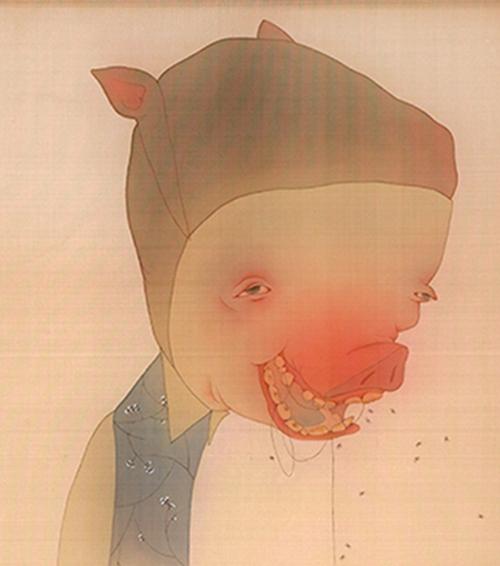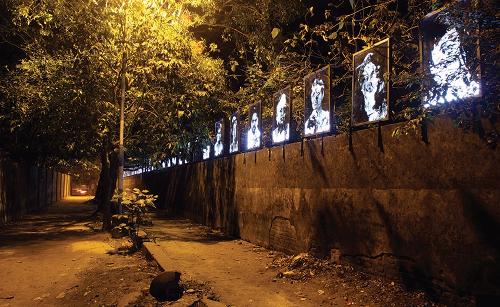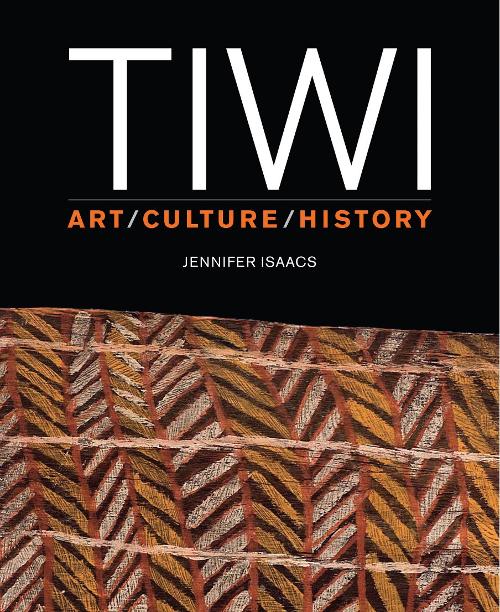
Walking into Holly Story’s latest exhibition at Turner Gallery in Perth, I realised she had carefully constructed the various components of the exhibition to create an immersive experience which simulated the walk that she has taken countless times over more than thirty years of investigating the bush around Deep River, which abuts the Walpole/Nornalup National Park in the South West of Western Australia. Like all good art, this exhibition engages a very specific site to alert us to a range of more global or universal themes.
A key component of the exhibition is Figures (B.grandis). These figures consist of the cones of the Western Australian native Banksia grandis, entirely clad in patches stitched together from old woollen blankets. This cladding is so snugly applied that one could almost say they were grafted, recalling the skin grafts burn victims have applied to repair their skin. The association with fire is also evident through some of the cones that seem to have their seed follicles open, which is how these plants survive after bushfire, releasing their seeds to regenerate in the ash.
The anthropomorphic reference in the title seems to refer to the primitive (female) figurative forms these cones assume when clad in this manner. Their bulges and bumps suggest hips and breasts, and are reminiscent of early stone sculpture like the Venus of Willendorf, long held to be a sculpture redolent with references to fertility. The seeds still embedded in the closed follicles here are congruent with such references. This is a powerful work on many levels and an excellent example of an artist with an acute material sensibility, able to marry form and content without demonstrative effort or self-consciousness.
Also central to this exhibition is the monumental work Red Canopy, a large ring of hand-stitched panels of secondhand wool blankets upon which Karri leaves have been steam printed in an intense red/vermillion/orange/brown. The leaf pattern clearly refers to the leaves one sees overhead in the bush, with chinks of light creating a mosaic-like effect. This pattern could also double as the leaf litter one sees underfoot when walking under eucalyptus. Here we are prompted to look above and below us (the title of the exhibition is Look Both Ways), as if the artist is leading us through her own navigation of the bush. The hole in the centre of this canopy could be for the trunk of one of the Karri trees contributing to this work, but when we turn around in the gallery to view the video work Spin, we see that this space is occupied by a woman who wears the canopy like an enormous skirt, spinning around to re-animate the leaves again. The camera only focuses on the spinning skirt, with an occasional glimpse of feminine legs, but it is a significant figurative presence for this artist, who has previously only alluded to it or consciously addressed its absence.
In contrast to the works with softer, used materials, Volute, Pod, Bloom and Bone flower evoke industrial or engineering associations. The use of (ribbed) canvas and machine stitching here recall the engineering of the corset or even certain types of nineteenth century scientific instruments. At first viewing, they could also be gentle manipulations of natural forms, but the more I looked, the more they exerted a surreal presence in the exhibition. In this manner, some of the work here has resonances with an artist like Louise Weaver, whose cladding of natural forms is undertaken not only with incredible dexterity of crochet and knitting, but with a refined ability to realign her conceptual intent through unexpected choices of materials and colour. I also thought of the South Australian ceramic artist Angela Valamanesh, whose recent transformations of natural forms are redolent with nineteenth century associations of biological morphology.
With openings (orifices?) at each end, these works seemed to be more like devices than simply passive objects. Perhaps these devices could be used to probe deeper into an understanding of what lies beneath the canopy at Deep River? Despite having made numerous responses to this part of the world for more than a decade now, there is a sense that the apparatus of the work in this exhibition exists in part to help the artist with her ongoing clarification of her bearings. Holly Story continues to be one of Western Australia’s most astute artists responding to the unique natural environment of the South West, and this exhibition is a significant new chapter in a long and sustained body of work.












